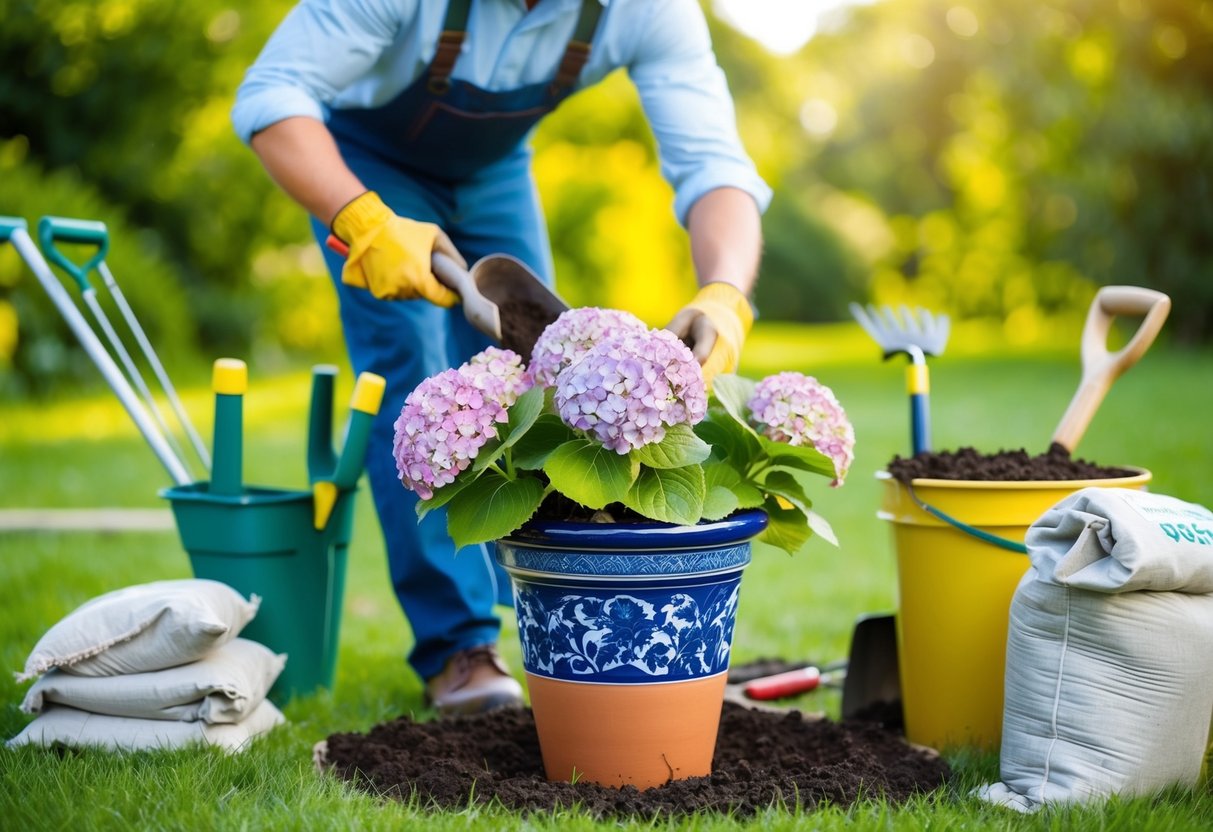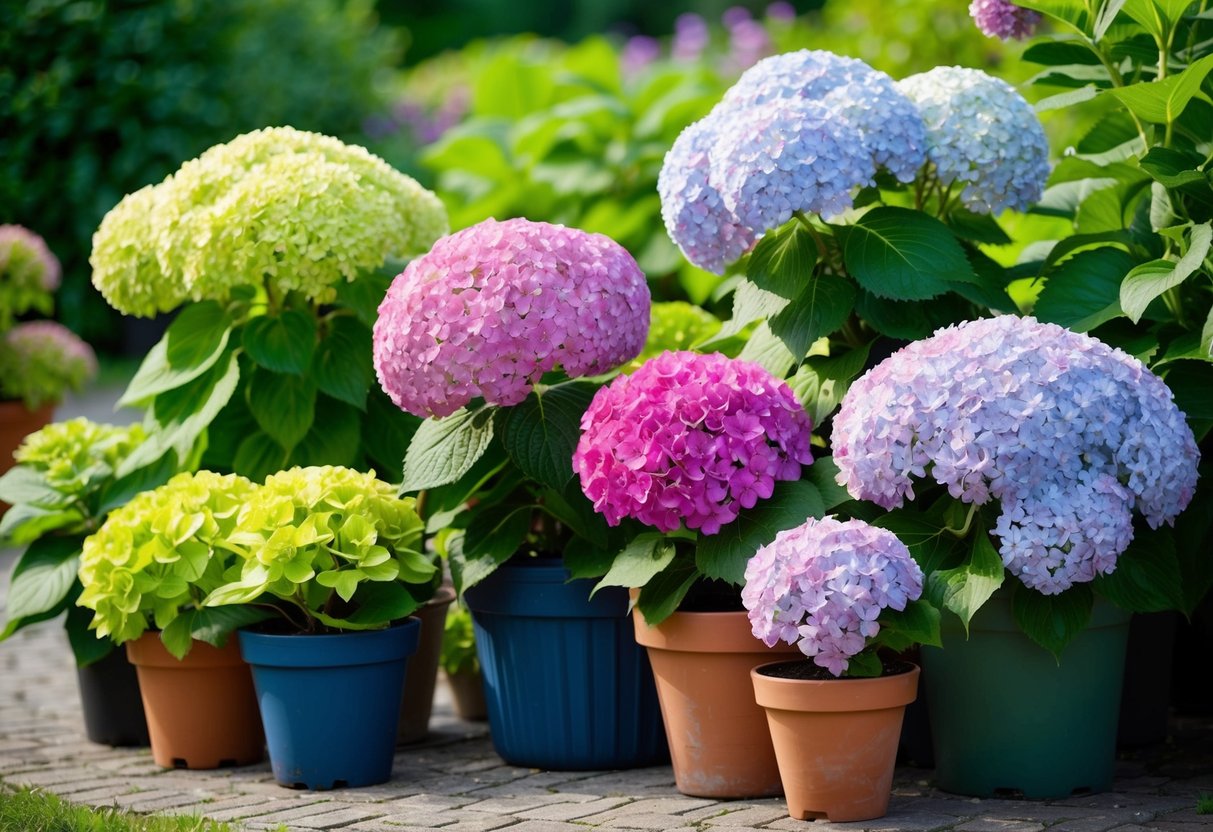Are Hydrangeas Best in Pots or Ground? Tips for Thriving Blooms
When you’re deciding between growing hydrangeas in pots or in the ground, consider your space and gardening goals. Hydrangeas thrive in both settings, but each has its advantages.
Growing hydrangeas in pots offers flexibility, allowing you to move them to catch the best light, or provide shade when it’s too hot. This can be especially helpful if you live in an area with harsh summers.

On the other hand, planting hydrangeas in the ground can give them more room to spread their roots, leading to larger bushier plants. They might require less frequent watering once established since they can access moisture stored deeper in the soil. You’ll enjoy their lush growth as they naturally find their place in your garden landscape.
Choosing the Right Environment for Hydrangeas

Choosing the right environment for hydrangeas involves understanding their specific needs for sunlight, soil, and moisture. Different varieties like Hydrangea macrophylla, Hydrangea paniculata, and Hydrangea serrata may have slightly different requirements. Here’s what you need to know to ensure your hydrangeas thrive.
Sun Exposure and Hardiness Zone
Hydrangeas generally need a mix of sun and shade. They typically require about 4-6 hours of sunlight daily. If you’re in a region with intense heat, consider providing shade during the hottest part of the day to prevent wilting and sun damage.
Different varieties may adapt better to certain climates. For example, Hydrangea macrophylla prefers milder temperatures and may be less tolerant of cold. In contrast, Hydrangea paniculata can be hardy in colder regions. Checking the hardiness zone can help you determine the best hydrangea type for your area.
Soil Type and Moisture
Hydrangeas flourish in well-drained, fertile soil with the right pH balance. Most varieties prefer slightly acidic to neutral soil. The soil should also retain some moisture but not be waterlogged, as excessive water can lead to root rot.
Maintaining consistent soil moisture is key. Using mulch can help keep the soil from drying out quickly, especially during dry periods.
If you’re growing hydrangeas in containers, ensure your pots have drainage holes to prevent water from accumulating at the bottom. Mulching also helps maintain the needed soil moisture for healthy growth.
Planting Hydrangeas

Hydrangeas can be planted in the ground or in pots, depending on your space and preference. Choosing the right location and container is important for their growth and health.
Ground Planting Basics
When planting hydrangeas in the ground, location is key. Look for an area that gets morning sun with afternoon shade. This helps prevent wilting during hot afternoons.
Before planting, loosen the soil to improve root growth. It’s ideal to mix in some organic matter to enhance soil quality and drainage.
Dig a hole twice as wide as the root ball but just as deep. Position your hydrangea in the center, making sure the top of the root ball is level with the ground. Water thoroughly after planting to settle the soil around the roots.
Pot and Container Selection
If you decide to grow a hydrangea in a pot, it’s important to choose the right container.
Look for one with proper drainage holes to avoid waterlogging, which can lead to root rot. The pot should be a few inches wider than the root ball to give the plant room to grow.
Use quality potting soil to ensure your hydrangea gets the right nutrients. A mix that retains moisture while also providing aeration works best.
Regular watering is essential, but be careful not to let the pot sit in water. This keeps the soil moist without drowning the plant.
Consider placing your potted hydrangea on a patio or porch to enjoy its beauty up close. Containers are great for adding color to these areas and can be moved to catch different light throughout the seasons.
Hydrangea Care and Maintenance

Taking care of hydrangeas involves regular watering, proper feeding, and occasional pruning. Understanding these needs will ensure that your hydrangeas grow healthy and vibrant, whether they’re in pots or the ground.
Watering and Fertilization
Hydrangeas need consistent moisture, so make sure you water them thoroughly. Aim for about 1 inch of water per week. This keeps the soil evenly moist.
Potted hydrangeas may need more frequent watering, especially in hot weather.
You’ll also want to feed your hydrangeas. Use a slow-release fertilizer in the early spring. This will nourish them throughout their growing season.
Avoid fertilizing after mid-summer, as this can interfere with their bloom cycle. If you prefer organic methods, try using compost or manure to enrich the soil.
Pruning and Seasonal Changes
Pruning hydrangeas depends on the type. For those that bloom on old wood, prune right after flowering to shape them and remove dead flowers. If your hydrangeas bloom on new wood, trim them back late in the winter or early spring.
Seasonal changes can affect hydrangea care. In fall, apply a layer of organic mulch to protect the roots from freezing. This also helps retain moisture.
Remember, watching the weather and adjusting your practices will ensure your hydrangeas thrive year-round.
Hydrangea Varieties and Selection

Choosing the right hydrangea variety depends on your gardening space and personal preference. Different types of hydrangeas offer various colors and bloom times, each with unique growing needs.
Popular Hydrangea Types
Among the popular hydrangea types are bigleaf hydrangeas. They are known for their large glossy leaves and can have either mophead or lacecap flowers. Mophead flowers are round and full, while lacecaps look more like a flat disc with tiny flowers in the center.
Another type to consider is the panicle hydrangea, which tends to have cone-shaped blooms. These are often white but can change to pink with age. They are known for their adaptability and can thrive in both pots and in the ground.
Oakleaf hydrangeas are notable for their leaf shape, which resembles an oak leaf. They offer a beautiful display in both summer and fall, with leaves turning rich shades of red and purple. These types prefer ground planting but can be potted with proper care.
Color and Bloom Time
The bloom color of hydrangeas can be fascinating and varies based on soil pH. For example, bigleaf hydrangeas can turn blue in acidic soil and pink in alkaline conditions. Knowing this, you can adjust your soil if you’re aiming for a specific color.
Bloom time is also an essential factor. Some hydrangeas, like panicle hydrangeas, bloom in late summer, extending the vibrant period in your garden. On the other hand, lacecap hydrangeas have a unique bloom structure that can add variety and interest to your plant selection.
By choosing the right variety based on your climate and soil, you can enjoy a beautiful and diverse hydrangea display.
Potential Challenges and Solutions

Growing hydrangeas can come with some difficulties, such as dealing with bugs or adjusting to environmental conditions. It’s important to keep an eye on both pests and diseases, as well as factors like temperature and humidity. By recognizing these issues, you can help your hydrangeas thrive.
Pests and Diseases
Hydrangeas can attract a range of common pests, like aphids, spider mites, and slugs. These can harm the plant by sucking on its leaves or leaving holes.
To manage these, regularly check the leaves for any signs of pests. Using insecticidal soap or neem oil can help address minor infestations.
Hydrangeas are also prone to certain plant diseases, such as powdery mildew or root rot, especially if they’re in containers with poor drainage.
To prevent diseases, it’s vital to ensure your pots have proper drainage holes. Avoid overwatering and allow the soil to dry out slightly between watering. Keeping the leaves dry, especially in the evening, can also reduce the risk of fungal infections.
Environmental Stress Factors
Environmental factors can play a big role in how well your hydrangeas grow. High temperatures and low humidity can cause stress.
So, keep your plants in a spot where they get some shade during the hottest part of the day. If you’re growing them in containers, you can easily move them to different locations as needed.
In some cases, hydrangeas can be toxic to pets, especially if consumed. So, be sure to place them in areas out of reach of curious pets.
For hydrangeas in pots, watering twice a week may be sufficient. Keep an eye on the leaves, as they will droop if they need more water, especially in hot conditions.







